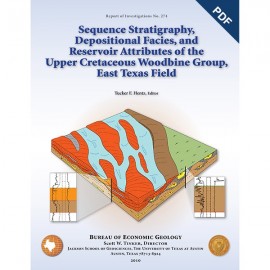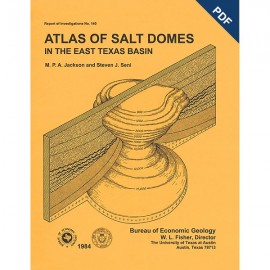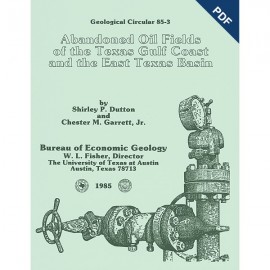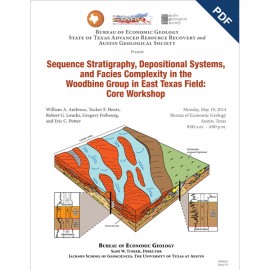Reports of Investigations
-
Books & Reports
- Reports of Investigations
- Guidebooks
- Udden Series
- Geological Circulars
- Down To Earth
- Atlases of Major Oil and Gas Reservoirs
- Texas Memorial Museum Publications
- Environmental Geologic Atlas of the Texas Coastal Zone
- Mineral Resource Circulars
- Other Reports
- Seminars and Workshops
- Handbooks
- Submerged Lands of Texas
- Symposia
- Annual Reports
- Open File Reports
-
Maps & Cross Sections
- Thematic Maps
- Miscellaneous Maps, Charts & Sections
- Geologic Atlas of Texas
- STATEMAP Project Maps
- Geologic Quadrangle Maps
- Cross Sections
- Highway Geology Map
- Energy and Mineral Resource Maps
- Shoreline Change and Other Posters
- Wilcox Group, East Texas, Geological / Hydrological Folios
- Bouguer Gravity Atlas of Texas
- River Basin Regional Studies
- Featured Maps
- Posters
- Teachers & the Public
-
Geological Society Publications
- Gulf Coast Association of Geological Societies
- Alabama Geological Society
- Austin Geological Society
- Corpus Christi Geological Society
- Houston Geological Society
- Lafayette Geological Society
- Mississippi Geological Society
- New Orleans Geological Society
- South Texas Geological Society
- GCS SEPM Publications
- Historic BEG & UT Series
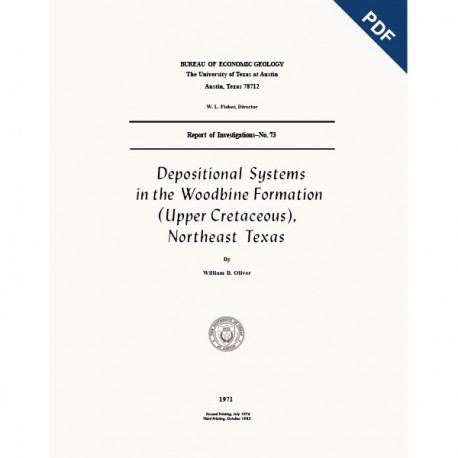
Depositional Systems in the Woodbine Formation... Northeast Texas. Digital Download
RI0073D
A free, digital version of this publication can be found on: Texas ScholarWorks
To purchase a print version (if available): RI0073
RI0073D. Depositional Systems in the Woodbine Formation (Upper Cretaceous), Northeast Texas, by W. B. Oliver. 28 p., 15 figs., 1971. doi.org/10.23867/RI0073D. Downloadable PDF.
To purchase this publication in book format, please order RI0073.
ABSTRACT
The Woodbine Formation is composed largely of terrigenous sediment eroded from Paleozoic sedimentary and weakly metamorphosed sedimentary rocks of the Ouachita Mountains in southern Oklahoma and Arkansas and subsequently deposited in a complex of nearshore environments along the margins of the broadly subsiding Northeast Texas Basin. Three principal depositional systems are recognized in Woodbine rocks--a fluvial system, a high-destructive delta system, and a shelf-strandplain system. Their recognition is based on a regional outcrop and subsurface investigation in which external geometry of framework sands was integrated with lithology, sedimentary structures, fossil distribution, and bounding relationships.
Two components of the fluvial system, a tributary channel sand facies and a meander belt sand facies, are developed in the Dexter Member (lower Woodbine) northeast of a line from Dallas to Tyler. To the south and southwest, a high-destructive delta system is persistent throughout the entire Woodbine section. The three component facies of the delta system are: progradational channel-mouth bar sands; coastal barrier sands, deposited along shore adjacent to the channel mouth; and prodelta-shelf muds. The Lewisville (upper Woodbine) shelf/strandplain system, developed in the northern third of the basin marginal to principal deltaic facies, is composed of two facies: shelf muds and strandplain sands, accumulated along shore.
Near the end of Woodbine deposition, but before transgression by Eagle Ford seas, emergence of the Sabine Uplift resulted in erosion of Woodbine sediments, which were subsequently redeposited along margins of the uplift as the Harris Sand. The close correspondence of Woodbine oil and gas fields with deltaic and strandplain sands suggests that on a regional scale facies distribution is as important as structure in governing the occurrence of hydrocarbons.
Keywords: depositional systems, Cretaceous, Northeast Texas, Woodbine Formation, Texas
Citation
Oliver, W. B., 1971, Depositional Systems in the Woodbine Formation (Upper Cretaceous), Northeast Texas: The University of Texas at Austin, Bureau of Economic Geology, Report of Investigations No. 73D, 28 p. doi.org/10.23867/RI0073D.

